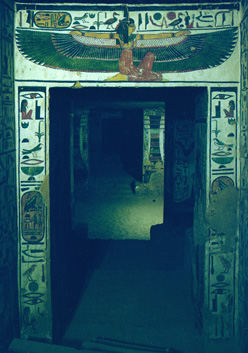Ankh, Snail, Blood, and Knot: On Nefertari’s Tomb
Introduction
Nefertari’s tomb has the best preserved and most eloquent paintings of any Egyptian burial site: it is the Sistine Chapel of Egyptian history, so to speak. The paintings on the tomb walls depict Nefertari’s journey after death to the afterlife, guided by various guardian-spirits and deities, including Isis, Hathor, and Osiris. The tomb was discovered in 1904, and quickly became world famous. You will see the reason why if you take the tour below.
Nefertari was one of several Queens of Rameses II, 1290-1224BC. [Her name is sometimes spelled Nofretari or with other variations, and she is NOT the same person as the more famous Queen Nefertiti, with whom she is sometimes confused.] Nefertari’s name means “the most beautiful.” The elaborate tomb for her was built by Rameses II near Thebes, in the royal burial grounds in Egypt.
What follows is a virtual journey into some of the meanings of objects and decorations in Nefertari’s tomb, her “house of eternity.” You will be led by a quirky guide with a flashlight to highlight the stunning graphics in the tomb, which hold the Egyptian key to the meaning of the afterlife. This virtual tour—I guarantee you—will be a little different from the others out there on the Web. The “real” tomb is now closed to the general public, due to the damage that viewers’ breath (their humidity) brought to the paintings.
The tomb may also be toured by a visit to your local library. The set of images used in this online tour is just a small selection, “fair use” I hope, of the thousands of images in the tomb that have been reproduced over the years in various media. The best are by the photographer Ekkehart Ritter, of Vienna, which were originally published in a book no longer in print. I’ve also used as a key text Hans Goedicke’s Nofretari: A Documentation of Her Tomb and Decorations (Graz, Austria: Akademische Druck, Univ. Verlagsanstalt, 1971.) For a full listing of sources used, see the Final Chamber page link below, the “Sources for Further Travel” section.
The images are not discussed in literal order, but rather are organized by theme and motif: you descend to deeper and deeper meanings. These interpretations are my own, based on my own research and my careful reading of texts on Nefertari’s tomb. As you make the descent, watch your spirit-level. For the mistakes that no doubt are here (I’m no Egypt expert, only what used to be called an amateur) I apologize; I hope what insights there are may be a counterbalance. Readers are welcome to send comments and corrections to me.
From fresco to codex (book) to e-text: a journey almost as full of surprises and wonders as the journey to the afterlife…. Begin:
Our Nefertari tour’s tomb-table of contents:
First Chamber in the Descent
Al Fresco
Osiris
On Skin Color
Protection Symbols; Symbols of the Male and Female
Second Chamber
On Osiris’ “Gatekeepers”
Knot-Glyph
Underground Fashion; or, Topless Goddesses
Queen Nefertari Herself
Hathor’s Touch
Final Chamber
Boogie Down
Isis and the Breath of Life
Stars Underground
From Virtual Tomb to Wrapping Paper
Sources for Further Travel

